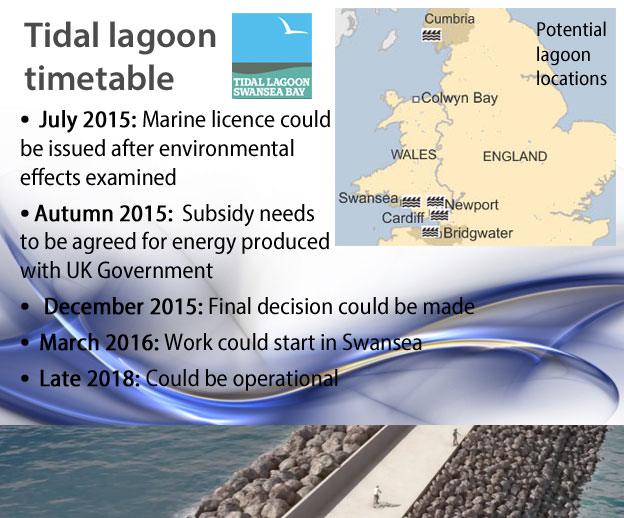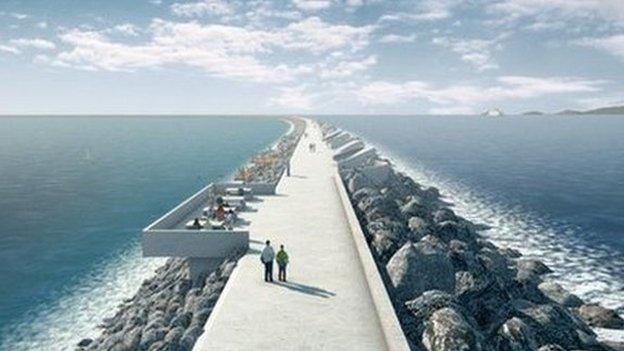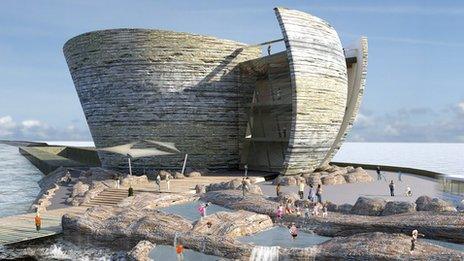Swansea Bay's £1bn tidal lagoon given go-ahead
- Published
BBC Wales environment correspondent Iolo ap Dafydd with the nuts and bolts of the tidal lagoon project - in 60 seconds
The building of a £1bn tidal lagoon in Swansea Bay has been given the go-ahead by the UK government.
Tidal Lagoon Power (TLP) says it will now negotiate how much subsidy will be paid for the energy.
That is still a big hurdle for TLP, which wants five other lagoons on the west UK coast to harness power, and needs a guaranteed price for it.
There are also concerns about the impact on the environment and migratory fish.
The backing by the Department of Energy and Climate Change (DECC), external is seen as a significant step forward for the developers.
Energy Minister Lord Bourne, who is also Wales Office Minister, said: "We need more clean and home-grown sources of energy, which will help to reduce our reliance on foreign fossil fuels.
"Low carbon energy projects like the tidal lagoon in Swansea Bay could bring investment, support local jobs and help contribute to the Welsh economy and Swansea area."
The tidal lagoon on the eastern side of Swansea Bay, between the docks and the new university campus, would use the flow and ebb of the tide to generate energy, which would then be converted into electricity.
Tidal Lagoon Power says it will now negotiate how much subsidy will be paid for the energy
But before the lagoon becomes a reality, there are three main challenges that need to be met:
The estimated cost of the project has almost doubled to £1bn. To make this scheme possible, a government subsidy for the power generated - a strike price - has to be agreed. The company is asking for a higher incentive than wind turbines, solar power and nuclear.
An updated validation report has to be completed, to convince the government that the technology is workable.
Environmental concerns regarding silting, sand dredging and potential impact on fish have to be addressed before a marine licence to allow the lagoon to be built can be issued.
The attraction for the UK Government is the potential for a new industry.
Thousands of construction and manufacturing jobs could be created, especially if five much bigger lagoons are built in the Severn estuary and off the north Wales coast.
There would also be a boost to the UK's standing as a generator of clean, green energy.



Mark Shorrock, chief executive of Gloucester-based TLP, said the project had the" potential to help transform our industrial economy and the UK's energy mix".
He added: "We see it as a game-changer, a scalable blueprint, paving the way for a fleet of lagoons that can work in harmony with nature to help secure the nation's electricity for generations to come."
Swansea council leader Rob Stewart called the news hugely encouraging for the city, saying it would boost leisure and tourism.
Friends of the Earth Cymru director Gareth Clubb also welcomed the news, adding: "Tidal power could further revolutionise Wales' energy mix - instead of relying on climate-wrecking fossil fuels, it could help us build a clean and safer energy future."
However he called for the government to make the most of existing renewable resources such as offshore wind and solar power.
Natural Resources Wales (NRW) will continue to assess the possible effects of the lagoon on the environment. A marine licence could be issued by the end of July.
If the decision is a positive one, work would start next March.
A Welsh government spokesman said: "We welcome this decision. Wales is well-placed to exploit the potential of marine energy and the Swansea Bay tidal lagoon project could create thousands of jobs during the construction and hundreds of permanent ones."

ANALYSIS by Iolo ap Dafydd, BBC Wales environment correspondent
Tidal energy has political muscle from both George Osborne and David Cameron behind it, while the developers claim the promised tourism and jobs from the project have strong support in the Swansea area.
But there are challenges too. Big ones.
There are environmental concerns about the impact on migratory fish. The Swansea lagoon would be between the Tawe and Neath estuaries. The potentially larger lagoon in eastern Cardiff could block the Rhymney estuary.
TLP still needs a marine licence from NRW whatever is decided in Westminster.
The impact of dredging and clearing on the bay, as well as sediment pollution, are other considerations. And the project could yet face legal challenges or calls for a judicial review.
Then there's the cost. A cool billion pounds for an energy output that would be a third of an average sized power station.
TLP and the UK Government now need to agree a guaranteed price for the energy generated.
Last year, the company asked for £168 per MWhe - higher than for nuclear, solar and onshore wind energy - but will not say the current detail of negotiations.
Higher tariffs are offered to wave and other marine technologies, but unlike energy lagoons, they are far in the future whereas staff at TLP want to be able to start building next spring.

Watch Tidal Lagoon Power's video of how the turbines would work
HOW THE LAGOON WOULD WORK:
A six-mile long seawall loops two miles out to sea from close to the mouth of the River Tawe and Swansea Docks and makes landfall close to Swansea University's new Fabian Way campus to the east
It would house 16 underwater turbines generating electricity on both the rising and falling tide
Enough renewable power would be produced for 155,000 homes (equivalent to 90% of Swansea Bay's annual domestic electricity use) for 120 years.
Source: Tidal Lagoon Power Ltd
- Published3 June 2015

- Published10 February 2015

- Published18 March 2015

- Published18 March 2015

- Published7 February 2014
